The Week in Estate Jewelry: Spiders, Flies, and a Bangle to Rule Us All
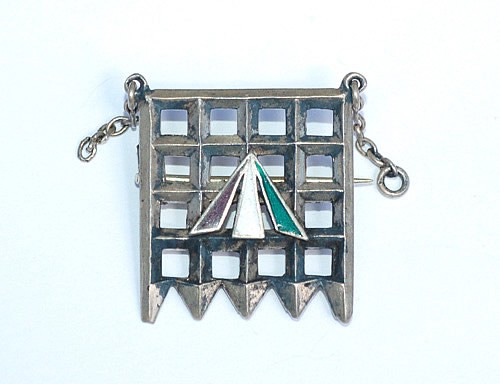
A while back, I told you guys about suffragette jewelry and how it encompassed both everyday jewelry and more specific ornamentation directly related to the struggle.
This brooch has already sold, but it’s still on the dealer’s site, so I’m thrilled that I can show it to you guys. This is a Holloway brooch. It was designed by Sylvia Pankhurst, the daughter of Emmeline Pankhurst, a leader of the British suffragette movement and the founder of the prominent women’s suffrage organization The Women’s Social and Political Union (WSPU). The WSPU’s motto was “deeds, not words,” and in addition to organizing rallies and protesting outside Parliament, they also advocated more-violent means of demonstration. Members smashed windows, set buildings on fire, and assaulted the police — sometimes in a deliberate effort to be arrested and therefore gain more publicity. When incarcerated, the women often went on hunger strikes and were brutally force fed. Their strikes were generally met with this public response.
This silver brooch was awarded to suffragettes who had been jailed in Holloway Prison. It is designed in the shape of a portcullis (representing the House of Commons), with prisoner’s chains on either side. In the center is an arrow enamelled the three colors of the suffragette movement: white for purity, green for hope, and purple for dignity. The arrow shape refers to arrow-like markings that decorated prison uniforms of the time.
Also, thanks to its presentation box, we know the provenance of this brooch: It was presented to Constance Collier in 1912. Collier was a hunger striker who had originally been arrested for smashing the windows of the John Lewis department store on Oxford Street in London. Her steel prison knife was, according to the dealer, “ironically and poignantly” included in the sale of the brooch.
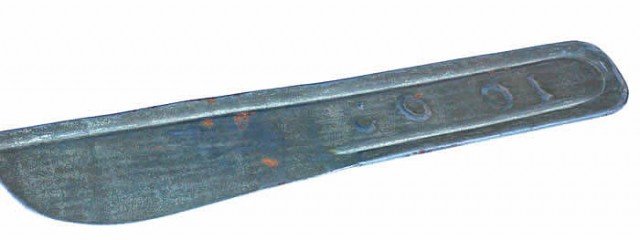
The inscription on the box reads: “Presented to Constance Collier by the Women’s Social and Political Union in recognition of a gallant action, whereby through endurance to the last extremity of hunger and hardship, a great principle of political justice was vindicated.”
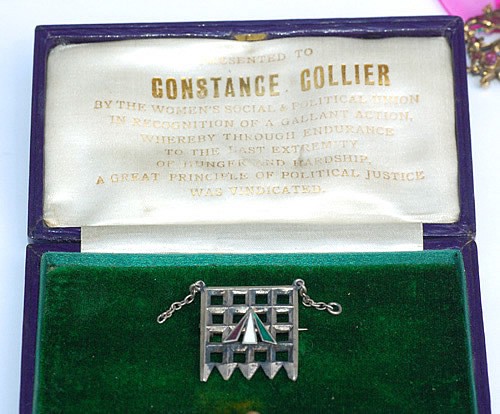
Note: If you want to see more on suffragette history, the Museum of London has a great online collection of everything from jewelry and medals to photographs, leaflets, and other ephemera. Go here and search for “suffragettes.” Also, American suffragists had their own version of the Holloway brooch. It was called the “Jailed for Freedom” brooch, and it featured a gate motif that was chained and secured with a heart padlock. It was also presented to women who had been jailed in the course of the fight for women’s suffrage. Reproductions are available here (although they’re currently sold out!).
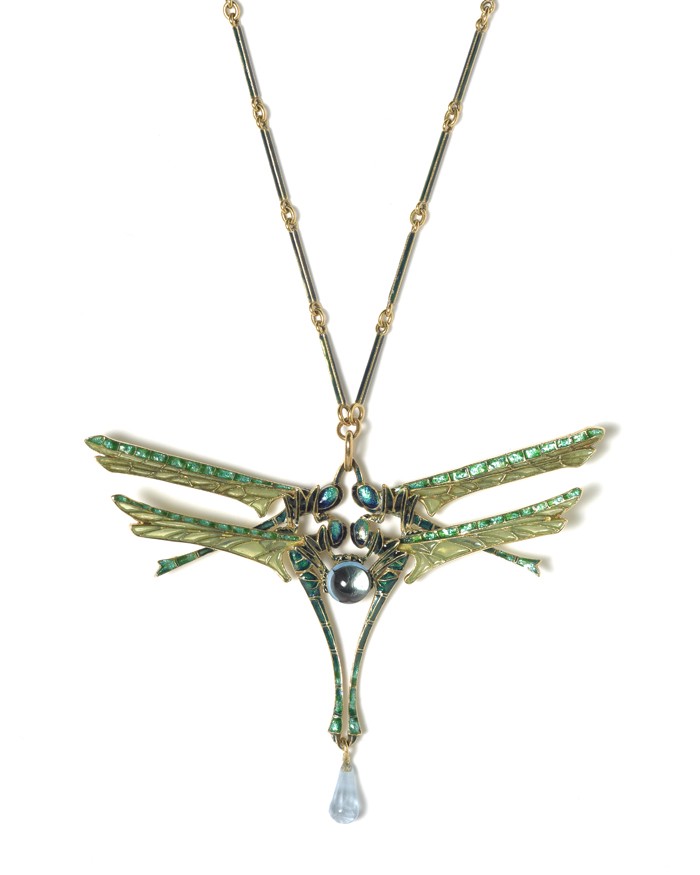
I can’t resist Lalique; he put so much study into his natural motifs that they often remind me of botanical drawings. This necklace, circa 1904, is just gorgeous. Four gold and enamel damselflies surround a central blue glass bead and drop. The insect’s heads, and the upper edges of their wings, are an opalescent, closed-back enamel, while the bulk of the wings are a pale green plique-à-jour enamel. The use of plique-à-jour allowed Lalique to replicate the delicate, translucent quality of insect wings. The chain is also gold with green enamelling.
A recent NY Times article declared that Lalique is back “in.” For a lot of us he never went out! But it’s worth noting that the Musée Lalique is set to open on July 2 in Alsace, France. The museum will spotlight the jewelry, glasswork, and decorative arts of René Lalique himself, as well as crystal pieces produced by later generations of his family and company.
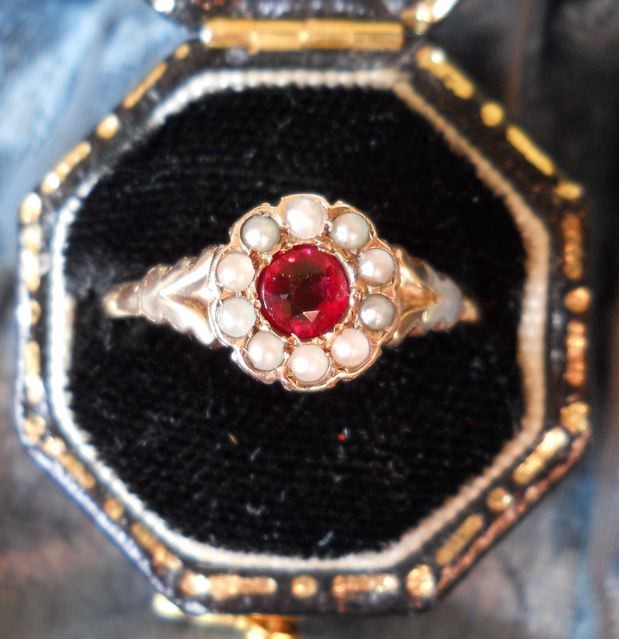
This cute little late Victorian (ca. 1885–1910) gold, ruby and seed pearl ring is proof that you don’t always have to break the bank to buy antique jewelry. There are lots of similar Victorian rings out there, and this one only costs $235.
(It has also had a seed pearl replaced. This is fairly common with any jewelry that has seed pearls, so if you own or buy a piece that uses them, have it checked by the dealer or a jeweler to make sure all the pearls are securely set. It’s so, so hard to find a replacement pearl in the same color and size, so better safe than sorry!)
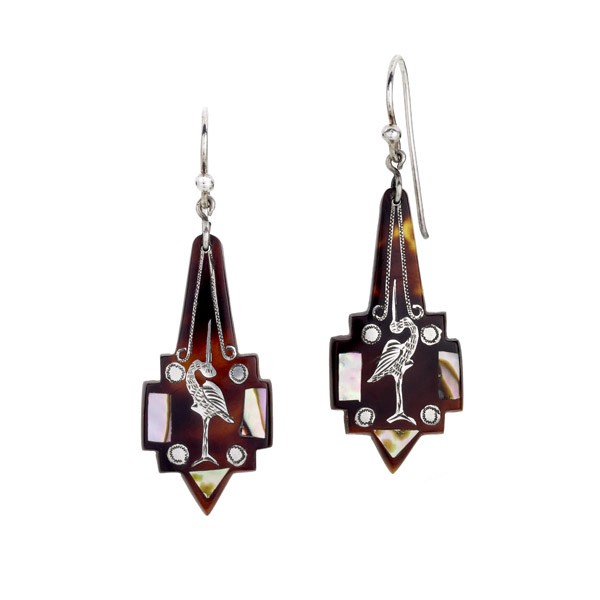
Circa 1920, these Art Deco tortoiseshell earrings feature a central crane motif in sterling silver, with little mother of pearl plaques inset along the sides and bottom. They’re 2” long.
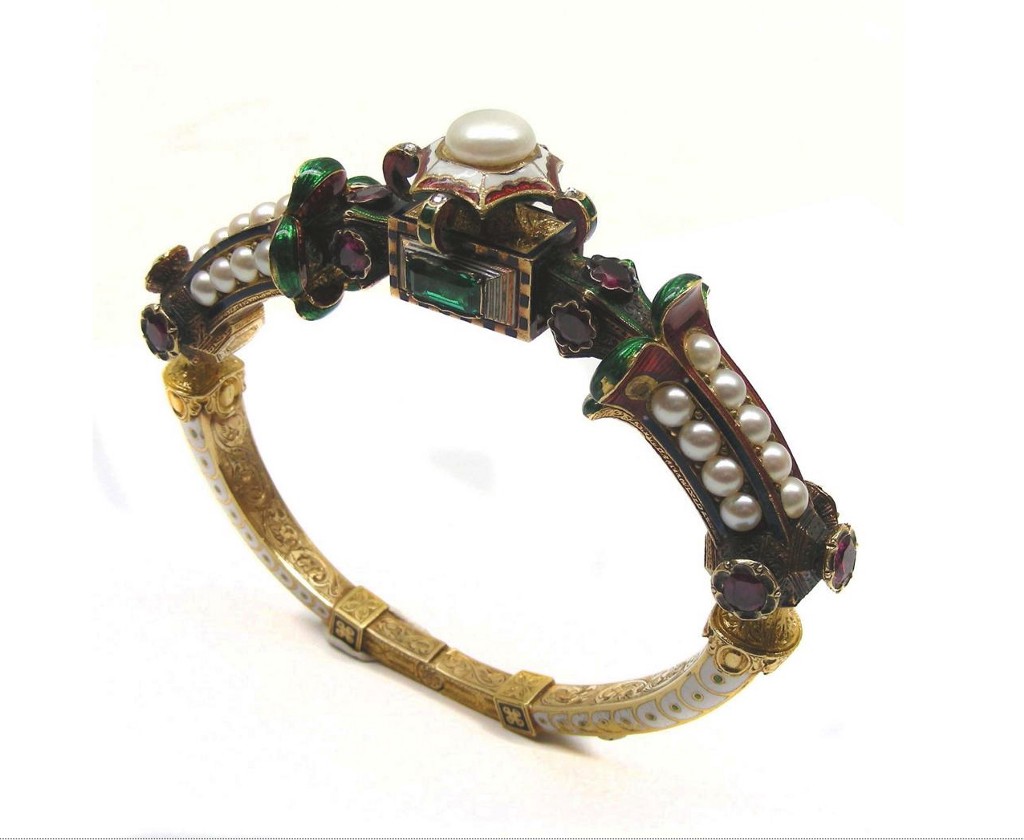
This bracelet makes my mouth go dry. Circa 1844, it’s a French hinged bangle in gold set with pearls, rubies, and emeralds. The central pearl is raised on a bed of gold and enamel, and flanked by two big emeralds. From there down, pearls and rubies are nestled within floral and scroll motifs that are further embellished with intricate engraving and green, red, blue, white, and black enameling. There’s also an inscription: “Florence 27 Mai 1844.”
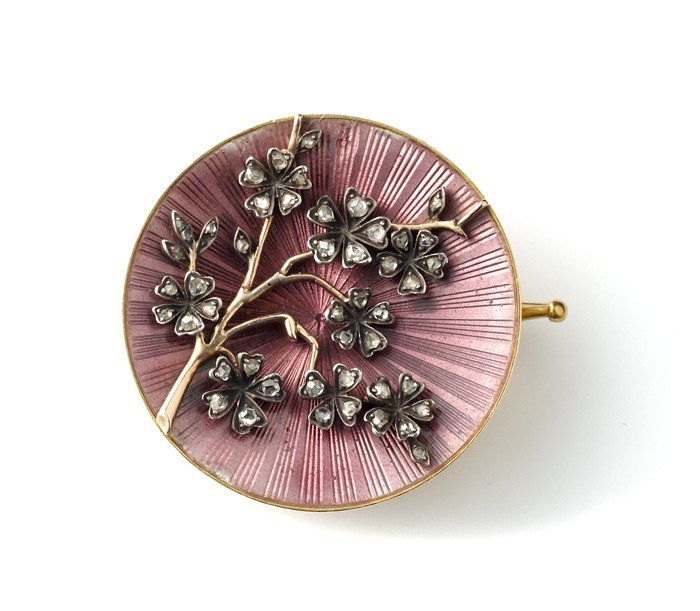
Fabergé! Circa 1899, this gold, enamel, and diamond brooch has a definite Japanese influence, with a branch of cherry blossoms sweeping over a circular base of starburst-engraved gold with translucent purplish-pink enamel. It’s by Fabergé workmaster Oskar Pihl, and comes in its original silk- and velvet-lined case.
Note: A big Fabergé exhibit is opening at the Virginia Museum of Fine Arts on July 9. The VMFA owns the largest public collection of Fabergé outside of Russia, and this exhibit, “Fabergé Revealed,” will include 400 pieces from the museum’s own collection as well as 150 items on loan from other museums and collections. The exhibit runs until October 2, and actually, it’s worth putting off a trip until AFTER July 30th, because that’s when another exhibit will open, focusing on jewelry and decorative objects created by the famous Tiffany & Co. designer Jean Schlumberger. You know, the guy who made this.
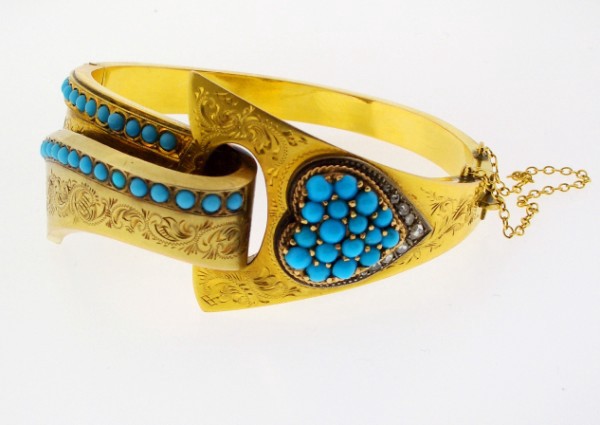
Victorian jewelry can sometimes seem excessively fussy or sentimental, but if you look past the trappings, some of those pieces have a strikingly modern feel. This 15k gold cuff takes the Victorian love for buckles to a highly-stylized level. It’s extensively engraved and set with turquoise-laden heart, but look at that whiplash design! The angles make me think of those space-agey Hamilton wristwatches from the 1950s. The bracelet is English, circa 1860.
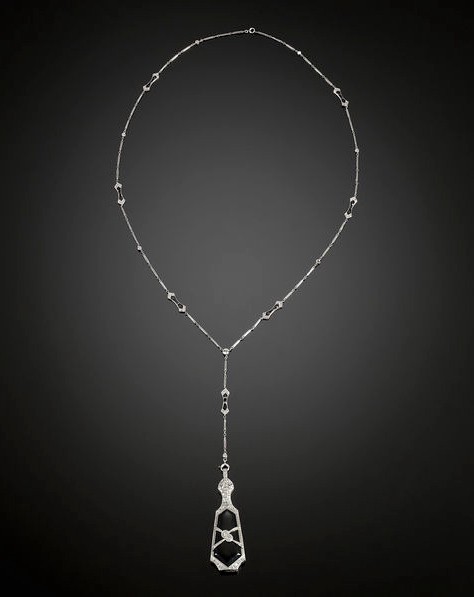
A lorgnette is a pair of glasses attached to a handle. In the 19th century they were often worked into items of jewelry, and women loved them for both their practical and fashionable purposes. This gorgeous platinum Art Deco necklace hides a lorgnette within its onyx and diamond pendant — the link at the top of the pendant releases the glasses, allowing them to be unfolded for use. The matching chain is also platinum, with onyx and diamond accents.
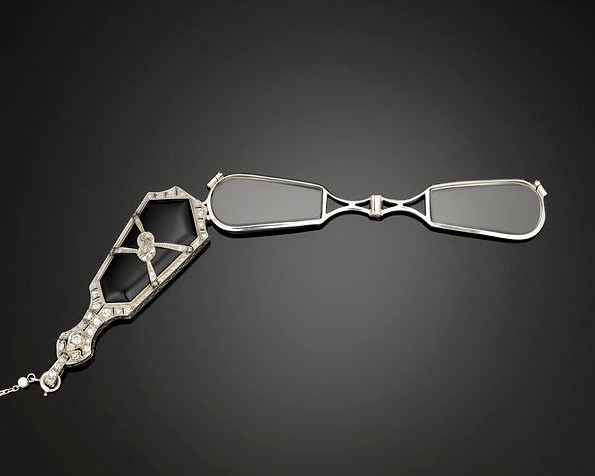
I have to confess that I’ve always wanted one of these, just so I could hold it up to my eyes and screech “a HANDBAG?!?!” 4,000 times until my friends smother me with a throw pillow.
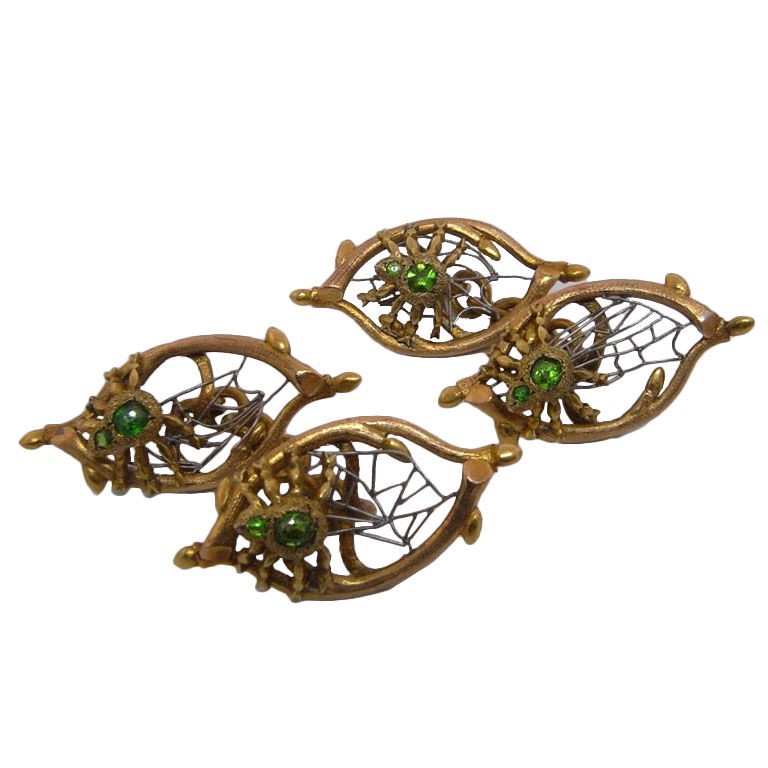
Spider cufflinks! These are Russian, early 20th century. Each link features a tiny 18k gold spider nestling in a web of platinum, surrounded by two twigs (also in 18k). The spiders are each set with two demantoid garnets. Yes, garnet! Unlike the the deep red garnet we’re familiar with, demantoid garnets are a bright, brilliant green. They were discovered in Russia in 1868, and quickly became popular with native jeweler Karl Fabergé and other fine jewelers all over the world. A new seam of demantoid was discovered in Namibia in the 1990s, but Russian demantoid is more highly valued and prized by collectors.
These earrings are a great example of Georgian cannetille work. Due to various wars, gold was scarce in Europe during the early days of the 19th century, and goldsmiths needed to make the most of what they had. Cannetille was a result. It’s a beautiful but economical technique that involves the working of fine gold wires into coils, scrolls, tendrils or beehive-shaped forms, with larger pieces sometimes incorporating thin sheets of gold. (It’s similar to filigree work, but unlike filigree, cannetille is three-dimensional.) It was an extremely labor-intensive technique — the goldsmiths did all of it by hand — but at the same time it allowed them to make large, ornate jewelry that actually used very little gold at all. Colored gemstones were also often incorporated into the designs, usually with closed backs. Cannetille jewelry began to emerge in Europe around 1820 and reached its height of popularity in 1830; after that it pretty much died out.
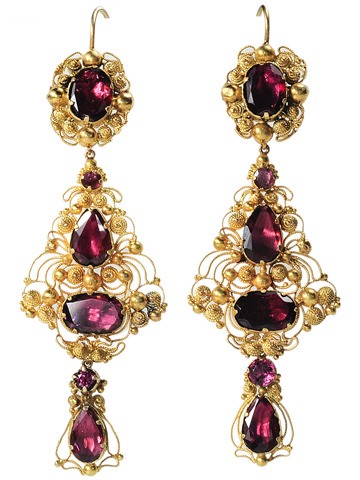
These earrings are 14–15k yellow gold, with fine cannetille work surrounding six closed-back almandine garnets. The dealer thinks they’re probably English in origin. Circa 1830.
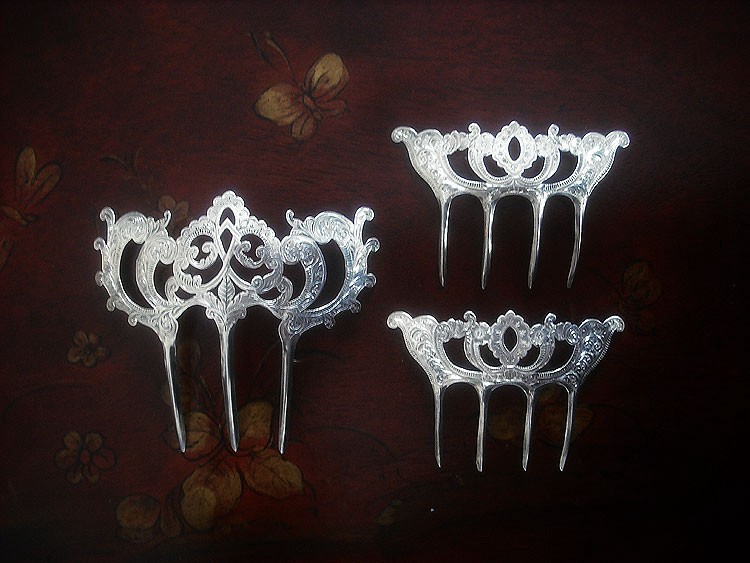
This is a very nice trio of English Edwardian sterling silver hair combs, all by the same maker (A. J. Bailey) and dated with the hallmark for 1905. The combs are intricately pierced and engraved, and all are of a good size: The smaller combs are 3.5” wide and 2.5” high, and the larger is 4.25” wide and 4 “ high. $450 gets you the set.
Previously: Micromosaics, Feathered Tiaras, and Mourning Jet.
Monica McLaughlin also sometimes paints for money. Her horribly out-of-date portfolio site can be found here: www.MonicaMcLaughlin.com.